On face value, this looks like the job of your worst nightmares. It most certainly won’t win any awards for job of the year, but for those in the know, it’s one of the quickest routes to fast cash you can come across. Luckily, the amount you will be paid for this job will almost certainly make up for the bad smell.
When you’re producing an estimate for debris removal, your price needs to take into consideration a number of factors. These include:
- Appliances that need to be removed and disposed of accordingly
- Hazardous waste (including deceased pets, chemicals, feces, etc.).
- Prohibited items
The HUD has a stringent set of guidelines pertaining to junk removal. For example, when it comes to the exterior of the property, they specify: “All exterior debris, including abandoned vehicles, is to be removed in accordance with applicable local laws.
Items of personal property that are securely affixed and in good condition, such as a swing set or dog house/kennel should not be removed if they add value to the property. However, if personal property is in disrepair or determined to be a health and safety hazard, it should be removed.”
During the process of the junk out, make sure you retain a copy of all receipts pertaining to waste disposal and salvage yard costs. Failure to do so may result in the realtor or asset management company refusing to pay your invoice. In addition to the receipts, you will also need the following information:
- The full details, including address, of the property from which the waste came.
- The number of salvage yards, waste disposal units at which the debris was discarded together with their full name and address.
- The number and type of appliances (e.g., freezers, dishwashers, washing machines, etc.) and where they were disposed of.
- A formal receipt that confirms hazardous waste and appliances were disposed of in an appropriate fashion and in accordance with the law.
- List of items that are not considered to represent general household waste (e.g., appliances, chemicals, batteries, vehicles, safety items, etc.), and how and where they were disposed of.
- The date any dumpster was brought to the property, the name, address and contact details of the dumpster supplier, and the date it was removed.
Again, you should take “before” and “after” photographs to document the debris removal process. Make sure you date each image and include the address of the property at which it was taken. Don’t forget this important step; sometimes, no photograph means no pay.
Tools Needed To Complete Debris Removal
- dump trailer or dumpster company on speed dial
- mesh tarp (for covering the debris load if using your own dump trailer or dump truck)
- 16′ ratchet straps (to properly cover and secure the load of debris prior to hauling it away)
- large flat shovel (to use as a dustpan)
- brooms
- dustpans
- rake
- mini-sledge hammer
- shop vac
- reciprocating saw (sawzall)
- gas powered generator
- 5 gallon gas can (so your generator doesn’t run out while you’re on the job)
- portable lights (for lighting up basements and attics)
- extension cords
- gloves
- 1-2 boxes of “contractor grade” garbage bags
- 2-4 heavy duty garbage cans
- 25-100 pack of dust masks
- first aid kit (just in case!!)
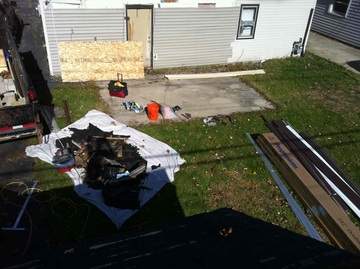
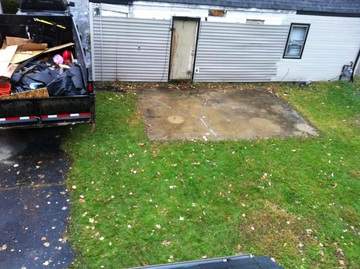
Videos Showing Examples of Removing Debris for a Property Preservation Work Order
FHA/HUD Attachment Regarding Debris Removal Requirements
Believe it or not, there are very strict guidelines that you must stick to when cleaning out a property or completing a junk out. These guidelines are set by the HUD and tend to be applied as the industry standard by lenders and realtors. You should use the HUD procedures as a basic guideline for conducting cleanup and debris removal services.
A Mortgagee may expend up to the amount listed in this attachment for debris removal without prior written approval from the M&M contractor. Costs such as labor hours, dump fees, and transportation (e.g., fuel, mileage, truck rental) should not be claimed in addition to the reimbursable amount as these costs are incorporated in the per unit allowable cost for debris removal. Before and after photographs are required.
The Department acknowledges that it is a common business practice of many property preservation contractors to wait until they have collected debris from several properties before taking the debris to an appropriate facility for disposal and that not all disposal facilities provide printed receipts.
Therefore, where such receipts are not available, Mortgagees will not automatically be denied reimbursement for debris removal. However, the Department must be able to confirm the type and amount of debris that was removed and that all debris was disposed of properly.
Therefore, Mortgagees must maintain a complete audit trail which will include: the name, address, and phone number of each company providing the debris removal service, the FHA case number and address of the property, the date of the disposal, the number of cubic yards of debris disposed and a listing of any items that are not ordinary household debris which would include health and safety items, tires, appliances, cars, trucks, boats, batteries, etc.
The documentation must also provide the name, address and telephone number of all disposal facilities used.
If a dumpster was brought to the property, the supporting information must identify the date the dumpster was delivered to the property, the date it was removed, and the name, address and telephone number of the company supplying the dumpster.
I. Exterior
Mortgagees should remove all exterior debris, including abandoned vehicles, in accordance with applicable local laws. Items of personal property that are securely affixed and in good condition, such as a swing set or dog-house/kennel should not be removed if they add value to the property. However, if personal property is in disrepair or determined to be a health and safety hazard, it should be removed.
Mortgagees must maintain, in the claim file, salvage yard and dump fee receipts that substantiate all claimed debris removal. The documentation must include the date, address of the property(s) for which the debris is being dumped, number of yards dumped, and the number and type of appliances (e.g., refrigerators, stoves, dishwashers) being dumped or disposed of. The receipt must indicate the name of the dump to verify that the debris has been disposed of legally.
Before and after photographs are required to support all required debris removal. Photographs should be dated and the property address indicated. If photographs are not available as documentation of required debris removal, HUD will not reimburse the Mortgagee for associated costs.
II. Interior (Including Attic, Basement, and Storage Spaces)
When performing the debris removal, you should remove pretty much everything. However, there are a few exceptions. You should leave behind the following:
- Debris that may represent a health or safety hazard.
- Debris then may incur a fine or lien.
- Debris that is flagged for removal by local law enforcement agents or legal teams at dates and times that are beyond the mortgagee’s control.
If you’re tasked with cleaning out the interior of the property, you should ensure that you remove all of the following:
- Any worn out carpet and flooring that is unsafe or not fit for use
- Waste that constitutes a health and safety risk (this will be covered in more detail below). Such waste includes dead animals, chemicals, needles, etc.
- Anything that the previous owners have left behind should be discarded, including furniture, photographs, kitchen utensils, homeware, etc.
Once again, you should document the entire process with “before” and “after” photographs to provide evidence of the amount of items you have removed. Make sure you date each image and include the address of the property at which it was taken.
III. Hazardous Waste Removal
Mortgagees are required to remove unhealthy or hazardous materials from the exterior and interior of properties prior to conveyance and should adhere to local municipal health and safety requirements with respect to proper disposal of said materials.
For additional clarification, the Environmental Protection Agency (EPA) website lists common household items containing potentially hazardous ingredients that might be found in a garage, basement, or other storage space. Further, as a matter of health and safety, refrigerators should be unplugged and refrigerator doors should be removed and stored if required by applicable state or local law or ordinance.
Materials considered unhealthy or hazardous that should be removed prior to conveyance include but are not limited to:
- Rotting food or other organic matter
- Diseased animals or pets
- Animal or human feces
- Pests
- Broken windows, glass, knives or other sharp objects
- Large containers of liquid, unidentifiable or not
- Large containers of paint or solvents that are in excess of 5 gallons
- Chemicals, paints or solvents that are stored in close proximity to materials that are potentially flammable (e.g., paper, fabrics, etc.)
- Highly flammable liquids such as oil, diesel, solvents, etc.
For the purposes of waste removal, the following items are not treated as hazardous waste unless they are found in abnormally large quantities:
- Fabrics, paper, etc. (unless stored in the proximity of flammable chemicals)
- Cleaning products, general household chemicals and insect repellents
- Paint and paint-related products (unless in excess of five gallons)
- Garden feed and lawn products
- Pool cleaning chemicals
EPA guidelines allow paint cans to be disposed of with regular debris, once treated. Paint is treated by brushing the paint onto cardboard or newspaper, allowing the empty can to dry with the lid off, or by adding absorbent material such as kitty litter, shredded newspaper, sand, or sawdust directly into the latex paint can. Dried paint may then be thrown in the trash and removed from the property as regular debris.
The M&M contractor must approve any costs associated with disposal action(s) required by a municipality.
Of course, you cannot always be sure as to whether or not waste products will be in a property in advance. As such, there are some basic steps you should take during the junk out to protect yourself and your team:
- Open the windows as soon as you enter the property. This will let in some much-needed fresh air.
- Wear appropriate PPE at all times. Even if you’re not aware that there is hazardous waste in the property, you don’t know what is lurking under that pile of trash. It’s a good idea to wear commercial-grade gloves and safety goggles at all times during the cleanup operation.
- If you come across a chemical, put a facemask on immediately. This will mitigate the effect of any fumes that emit from the packaging or bottle as you move it or in the event you drop it.
Handling Refrigerators
Refrigerators need to be handled with great care because they can be extremely dangerous. You should unplug them immediately upon entering the property. Depending on the regulations of the state in which you operate, you may also be required to remove the door. Many states operate refrigerator-recycling programs.
Research these in advance. In some areas of America, a representative will collect the refrigerator from site, while in other areas you will be required to take the item directly to the collection facility. Contact your local landfill for information about the appropriate steps to take.
IV. Bug and/or Pest Infestation
If, on the initial inspection, the Mortgagee finds evidence of pests (e.g., roaches, water bugs, mice, rats) that does not prevent clean-out of debris or is not a health or safety hazard, the Mortgagee may use over-the-counter products to exterminate the bugs.
If the property is found to be infested with pests that constitute a health or safety hazard or prevent the clean-out or debris removal, the Mortgagee may utilize a professional Pest Control Service. A flea infestation does not require photographic evidence.
V. Personal Property and Debris Removal during Evictions
Some jurisdictions require a legal eviction to remove personal property from a vacant house. Mortgagees should follow local code and laws and exercise good judgment when distinguishing between personal property and debris.
If Mortgagees have questions regarding personal property and debris, they should consult local counsel. If a Mortgagee is required by local law to remove trash and debris from the property as part of an eviction and the Mortgagee has no control over the timing of removal, the costs for removing the items are considered eviction expenses and are not subject to the debris removal cost guidelines, the maximum securing fee or the overall allowable cost limit.
These costs are to be claimed as man-hours and should be deemed by the M&M contractor to be reasonable and customary for services performed in the area.
A) Personnel
In most circumstances, no more than four people should be necessary to complete an eviction for a townhouse or condominium and six people for a single family detached dwelling. If local law provides that a specific number of people should be provided, or if the law enforcement official conducting the eviction identifies a need for additional people to be present at the time of the eviction, this information must be documented in the claim review file.
Similarly, if local or state law requires that a service be performed within a certain time frame or subject to specific removal or storage requirements, those requirements must be fully documented in the claim review file and costs are not subject to the allowable cost limit for the jurisdiction.
The removal of curbside debris following an eviction will be reimbursed as man-hours. No more than four man-hours at $20 per man-hour, per person at the scheduled eviction will be reimbursed for the removal and disposal of eviction debris. Dump fees and storage fees (as appropriate for the jurisdiction) will also be reimbursed.
If crews show up for canceled or re-scheduled evictions, the Mortgagee is only eligible to claim a maximum of one man-hour at $20 of labor per person.
B) Photographic Evidence
Photographs are required to support all personal property/debris removed from a property as part of an eviction. Eviction costs should be entered in item 305 of Part D of the claim form.
VI. Over-allowable Requests for Debris Removal Services
Mortgagees should obtain prior written approval from the M&M contractor for any debris removal expense that exceeds the cost per cubic yard or the total allowable number of yards indicated in the schedule. When requesting approval to exceed the debris removal cost limit, the Mortgagee should obtain two independent competitive bids. If the Mortgagee utilizes a field service company, that firm may provide one of the bids.
The Mortgagee should obtain a second independent and competitive bid and submit the bids to the appropriate M&M contractor with an over-allowable request. Field service companies or contractors may not submit second bids directly to the M&M contractor. This violates the integrity of HUD’s requirement for an independent and competitive bid process.
The bids should specify the types and location of the debris, the number of cubic yards, and include photographic documentation. Any additional costs of non-general refuse should be factored into the final bid and clearly indicated for M&M contractor review.
All second bids will be on the bidding company’s letterhead and will include the bidder’s name, address and telephone number. Upon receipt of the bids, the Mortgagee should date stamp them and attach them to a Request to Exceed Cost Limit for Preservation and Protection.
Additionally, the Mortgagee should identify all other preservation and protection expenses to-date so that the M&M contractor will know if and by how much the Mortgagee will exceed the maximum allowable cost limit. Debris removed per local code is also subject to the established cost limits on debris removal. Mortgagees will not be reimbursed for the cost of obtaining bids.
Upon receipt of the required bids, the M&M contractor will, within five business days, take one of the following actions:
- Notify the Mortgagee to accept one of the bids submitted;
- Reject both bids and provide the Mortgagee with examples of similar work that has been recently performed at a more reasonable cost,
- Notify the Mortgagee to convey the property without removing the debris.
Keeping Track of the Junk
It’s important that you track how much junk you take out of the property but, for obvious reasons, this is much easier said than done. It’s not going to be possible to count every single item you remove; as such, you will need to rely on your powers of estimation to keep tabs on how much you haul away.
One of the best ways to do this, is to calculate the amount of junk you extract in relation to the size of the truck you put it in. For example, if you are using a 10’ truck (which has a capacity of 15 cubic yards) and you fill it 80% full of trash, you can safely estimate that you have extracted around 12 cubic yards of junk. Don’t worry, I’m not expecting you to know the cubic capacity of the various trucks that are available.
I have included a set of U-Haul charts that contain a list of the cubic yard capacity of each vehicle rental that is available. Keep this handy so that you can keep track of how much junk you remove from the property; you will need this for bid and invoicing purposes. If you are deciding between two vehicles for the purposes of removing junk, always go with the highest.
The cost between the two is usually pretty negligible, around $10-$20 and it’s much cheaper than having to pay two visits or, worse, having to hire a vehicle for a second day because you didn’t manage to fit everything in the truck on the first visit.
If all the above information and tips teach you one thing, it’s that you absolutely must go and visit the property before you submit a bid for your cleaning services. Without seeing the severity of the junk and the condition the property is in, you have no idea what truck to hire, how many people you’ll need and how much time it is going to take you to clear the place out. It is only through seeing the place first-hand that you can generate a realistic bid.
Examples of How the Debris Quantity is Calculated in the Property Preservation Industry
Debris and Personal Property Sizing Table
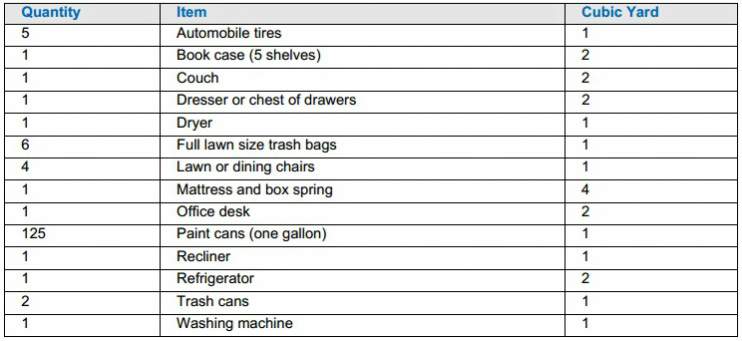
Your Local Landfill
Every municipality operates different rules and regulations pertaining to household waste. However, the basic rules are pretty similar across the board. Below, you will find a general overview of prohibited waste and acceptable waste. This is intended as a basic guide only, make sure you research what the specific regulations are in the area in which you operate in advance of formulating a bid.
Prohibited Waste Items
- Regulated hazardous waste
- Polychlorinated biphenyls (PCBs) or any waste that includes PCBs
- Radioactive wastes
- Infectious wastes
- Commercial quantities of liquid waste
- Special wastes
- Friable asbestos containing wastes
If you come across any of the items listed above when you’re cleaning out a property, and you may need to enlist the services of a firm that specialize in the removal of prohibited waste items. You will find such companies by performing a basic online search for “hazardous waste disposal services” or “environmental services.”
Conditionally Acceptable Waste
The items that are listed below will usually be accepted at landfills providing they are handled in an appropriate manner, and certain criteria are met. These are as follows:
- Non‐friable asbestos-containing wastes are accepted at some landfills providing that they have been handled in an appropriate manner. Contact your landfill to verify the details.
- Industrial waste and/or contaminated commercial products may sometimes be accepted but you will usually be required to obtain approval in advance to ensure that you comply with the relevant requirements.
- Containers that are in excess of five gallons will only be accepted if they are open, empty, or contain less than an inch of dried waste that is officially unusable.
- Some landfills will take refrigerators providing you have proof that the CFC has been removed in accordance with EPA requirements.
- Some landfills will accept tires.
- Propane and Freon containers may be accepted providing the values have been removed.
- Dead animals and animal parts will require special handling. Check with the landfill in advance.
The Previous Owners’ Personal Property
This can be a tricky one. In some states, personal property cannot be removed from a home unless a formal eviction notice has been served. Before you enter the property, make sure you have verified the current situation in terms of what the laws are in your area and the availability of any warrants and eviction notices.
When you’re clearing out a property, you may find it difficult to determine what’s personal property and what’s trash. If you are unsure about any particular item, it is best to contact your lawyer for some advice.
Number of People Required During Eviction
In some cases, there may be guidelines or regulations in place that specify how many people are allowed to enter a property for the purposes of clearing it out. For example, HUD requirements specify that four people should be sufficient to complete an eviction for a townhouse or condo, while six may be required for a bigger family home.
Check the laws in advance and make sure you adhere to them at all times. You don’t want to find yourself in hot water at a later date because you haven’t followed protocol. In some cases, the law enforcement agent may specify that additional people are required to carry out the eviction or that it must be performed within a given timeline. Make sure this is documented and all records are shared with the realtor or relevant asset management company.
After debris removal, it’s time for Maid or Cleaning Service.

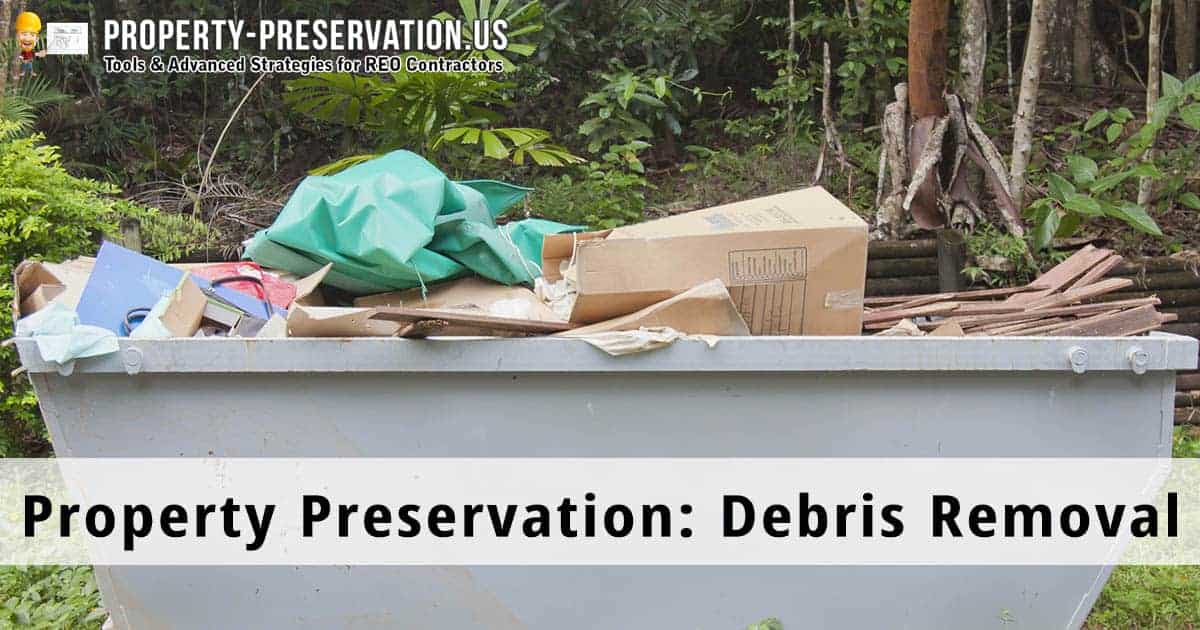


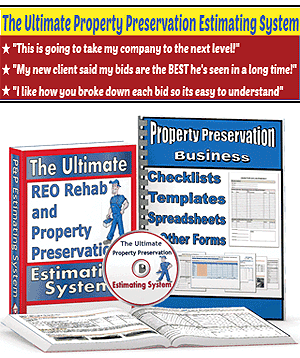
So please does it means the work actually depends on the work load, materials, distance to location, tools needed, pictures for prove and number of work men that result in the amount of debris to be removed and other stuffs.
I’m looking for Imformation on learning how to bid trash outs ,trimming ,initial cuts and clean.I would like for me and my wife to make a decent living.Instead of getting bet out money by these Regionals because of our lack of knowledge .Thanks I learned more then what the company who sub contract us out were willing to teach.
We recently discovered a 500 sq foot dump on some property we aquired. We want this dump removed. What type of professional or company do that type of job?